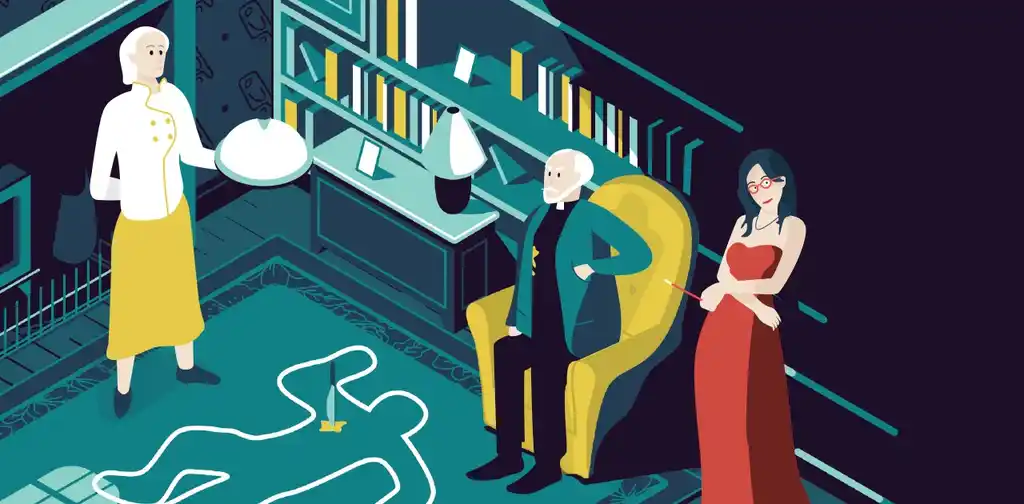Last updated on Oct 14, 2025
Multiple Points of View: 7 Tips for Writing from Different Perspectives
Dario Villirilli
Managing Editor of the Reedsy blog, Dario is a graduate of Mälardalen University. As a freelance writer, he has written for many esteemed outlets aimed at writers. A traveler at heart, he can be found roaming the world and working from his laptop.
View profile →Writing from multiple points of view has become increasingly popular in recent years. From Gone Girl to Game of Thrones to Normal People, using multiple viewpoint characters allows you to expand the scope of your story, giving readers additional insight into characters and plot points.
However, there are pitfalls to this approach as well. To help you balance multiple points of view and avoid POV overload, here are some important points to keep in mind when telling a story from multiple perspectives.
1. The bigger the cast, the bigger the scope
By its very nature, a story with multiple points of view is going to be a “larger” story than one with only a single perspective. Not necessarily longer, but bigger in scope. Stories with multiple points of view deal usually deal with more character arcs, situations, and settings.

The ability to broaden the scope is one reason why epic fantasies so often rely on multiple points of view. However, it applies just as much to quieter, more literary stories. Contrast Mary Beth Keane’s Ask Again, Yes with Ann Patchett’s The Dutch House. Both are family sagas that follow their characters across many decades; both are powerful and introspective stories that dive deep into the lives of their characters. However, the focus of The Dutch House is specifically about the protagonist. Consistently throughout his life, he feels isolated and alone, and his singular point of view backs up this sensation with its tight focus. Ask Again, Yes, by contrast, gives us scenes from multiple members of two families, and the world of the story feels like it takes up more space as a result.
Each author made a deliberate choice with their points of view that compliments the goals of the book as a whole.
🖊️
Which POV is right for your book?
Take our quiz to find out! Takes only 1 minute.
2. Don’t add more points of view just for the sake it
Just because you want a story to feel larger, that doesn’t mean you want to include scenes from every character. We’ll get into how to choose your point of view characters in a moment, but before you decide that, you should consider how many you’re willing to include.
As a rule of thumb, you’ll probably want fewer POV characters than you think — especially if this is your first novel. Each viewpoint character adds complexity to the story, as each viewpoint character now requires added depth and a satisfying character arc. The logistics can also get tangled quickly with multiple perspectives, so be careful! Be sure to develop each character's perspective, and progress their stories evenly to maintain consistency across the entire story.
Hire a book coach to nail the perfect POV
Angela Yuriko S.
Available to hire
Publishing coach, multi Bram Stoker Awards® Winner+, publisher of Space and Time and Authortunities, a calendar of author opportunities.
Eric S.
Available to hire
Eric is a literary agent and Young Adult author who has worked on award-winning and New York Times bestselling books.
Daisy W.
Available to hire
Former commissioning editor at HarperCollins. I’ve been editing bestselling, prize-winning fiction (crime, romance and more) for 10+ years.
Yes, someone like George R.R. Martin can pull off a huge cast of point of view characters effectively — but he has years of experience, and even then, he still writes himself into corners sometimes. By all means, don’t be afraid of large POV casts, but know that you’re undertaking a lot more complexity. It’s not a decision to be made lightly. If you are going to use a large cast...
Maintain balance at all times
Adding more points of view also makes it harder for the reader to keep track of each person — especially if the characters spend their time in different places. Each additional character brings with them a whole new supporting cast and plot thread for readers to remember and stay emotionally invested in. Be sure to check in with each viewpoint character often enough that readers remember what's going on.
Whenever you’re deciding on point of view, ask yourself: is this person’s perspective necessary to understand the story? On that note…
3. Make your characters work for the spotlight
Characters always need to serve a purpose in your story — otherwise, why are they there? This same rule goes double for viewpoint characters. After all, nobody wants to spend time with a character who’s going to sit on the sidelines the whole book.
Whenever you’re considering adding another point of view character, ask yourself:
Does this character have a unique perspective?
Above all, viewpoint characters should be interesting. They’re the filter through which we’re going to experience the story, after all, so they’d better have something to offer! Readers won't enjoy spending time with a character who doesn’t react to the plot in unique and interesting ways.
Are they present during important moments in the plot?
Another way to decide on viewpoint characters is by simply looking at who’s around for important moments. Readers only see things when your viewpoint characters do — so you’re going to need to make sure they witness your best plot points.
More than simply picking a character who’ll be present, though, make sure you choose a character who will be impacted by the events they’re experiencing. Readers want active characters who make choices and drive the plot forward.
Do they know information other characters don’t?
If a piece of information is important for readers to know, a big consideration is which characters will have this information — and when they find out. Revealing information through your characters is a great way to make sure you show (and not tell) what’s happening in your story.
The inverse is also important to consider: if you have a plot twist and you don’t want readers to know about it beforehand, make sure you’re not writing from the perspective of someone who would give it away!
Now that you know how to choose your point of view, let’s take a look at how to use multiple points of view effectively.
4. Keep ties between your viewpoint characters
While it’s true that each viewpoint character needs their own arc, don’t lose sight of the fact that they still belong to the same story.
Even if your characters don’t spend much time together, they should probably meet at least once. Regardless of how often they interact, though, make sure their story lines impact each other. It can be as subtle as a ripple effect or a counterbalance making a thematic point, but it should always be obvious to the reader why these characters are part of the same story. Otherwise, they'll be left wondering what the point was.
5. Every character should have a unique voice
When writing multiple points of view, clarity is everything. To that end, your reader should be able to flip ahead to a random page and quickly identify who is telling the story. How would they do that? Character voice.
If you’ve followed our advice and chosen characters who have a unique perspective, this should be fairly easy. Still, it’s important enough that it’s worth really nailing down the voice and worldview of each character.
When crafting your viewpoint characters, make sure you…
Give each character their own vocabulary
An easy way to establish voice is to mix up your word choices. For example, if one character came from a prim and orderly background, they might have a more esoteric vocabulary than one who was raised on the streets. The first character could use sophisticated sentence structures and have a vocabulary that would make an SAT proctor proud. The second may speak in more direct sentences and use slang or shorthand phrases.
Infuse your character’s perspective into the scene
Remember how you chose your character based on their unique perspective? It’s time to make use of that!
As well as reacting to the plot in compelling ways, a viewpoint character should infuse their own impression on events. So if they’re a pessimist, the narrative from their point of view should reflect that. The same goes if they don’t like one of the other characters — the descriptions of that character aren’t exactly going to be flattering, are they?
Even the things they notice and describe should vary based on the point of view. Just think how differently Sherlock Holmes novels would read if they’d been written from Holmes’s perspective instead of Watson’s! All those little details that Watson doesn’t notice would suddenly get a great deal of description.
6. Only mix first person and third person for a reason
One way you can define a character’s voice is by telling one perspective in first person (“I, me, mine”), and the other in third person (“he, she, they”).
However, this approach should be done with care — if you decide to use it. Mixing first person and third person in the same story can be jarring or confusing to some readers, and it might prove harder for you to create a sense of consistency throughout the novel.
That said, some novels use this trick to great effect. Just ask yourself why you want to mix first person and third person. Consider:
- How does it change the way readers experience the story from viewpoint to viewpoint?
- Are you trying to create extra distance between the characters?
- Is there information you need to hide, that wouldn’t reasonably be hidden in the first person?
- Is one of the characters colder and more analytical than the other, and you want to highlight the difference?
These aren’t the only reasons you might want to mix perspectives, of course. Just make sure your decision is intentional and moves the story forward effectively. As long as you’re not mixing it up for the sake of mixing it up, you should be okay.

FREE COURSE
Understanding Point of View
Learn to master different POVs and choose the best for your story.
7. Don’t hide when you change points of view
One of the most important rules of writing is Don’t Confuse the Reader. When writing multiple points of view, remember that readers aren’t psychic — they won’t know you’re changing viewpoint characters unless you tell them. There are two easy and effective ways to do this.
Change POVs at the start of each chapter
Make sure you let readers know immediately that the perspective has changed. The simplest way to do this is by labelling the start of each chapter like in A Game of Thrones, where the table of contents reads like a character list.
Establish your new POV character quickly at the start of each scene
If changing points of view at a chapter break doesn't fit with your plot structure, you can also do it at a scene break. Just be sure to use the first sentence to immediately establish the new viewpoint through the setting, distinct voice, and which characters are present. Something like:
As soon as Henry stepped onto the train, he knew he’d made a right ol’ mistake.
Or:
Abby couldn’t believe she’d been so ready to accept what Michael had told her.
Whatever you do, don’t change the point of view in the middle of a scene. This is known as “head hopping” and it’s incredibly jarring and difficult to follow. So if we’re being taken through the scene from Tony’s perspective, don’t suddenly start describing things from Joan’s instead.
Remember, all of writing is an art — but that doesn’t mean there aren’t guidelines to make the process easier. Writing from multiple points of view is a challenging but rewarding task. The next time you sit down to write, ask yourself: how would it change the story to add another viewpoint? How would it change to remove one? Don’t be afraid to experiment! We can’t wait to see what you come up with.




